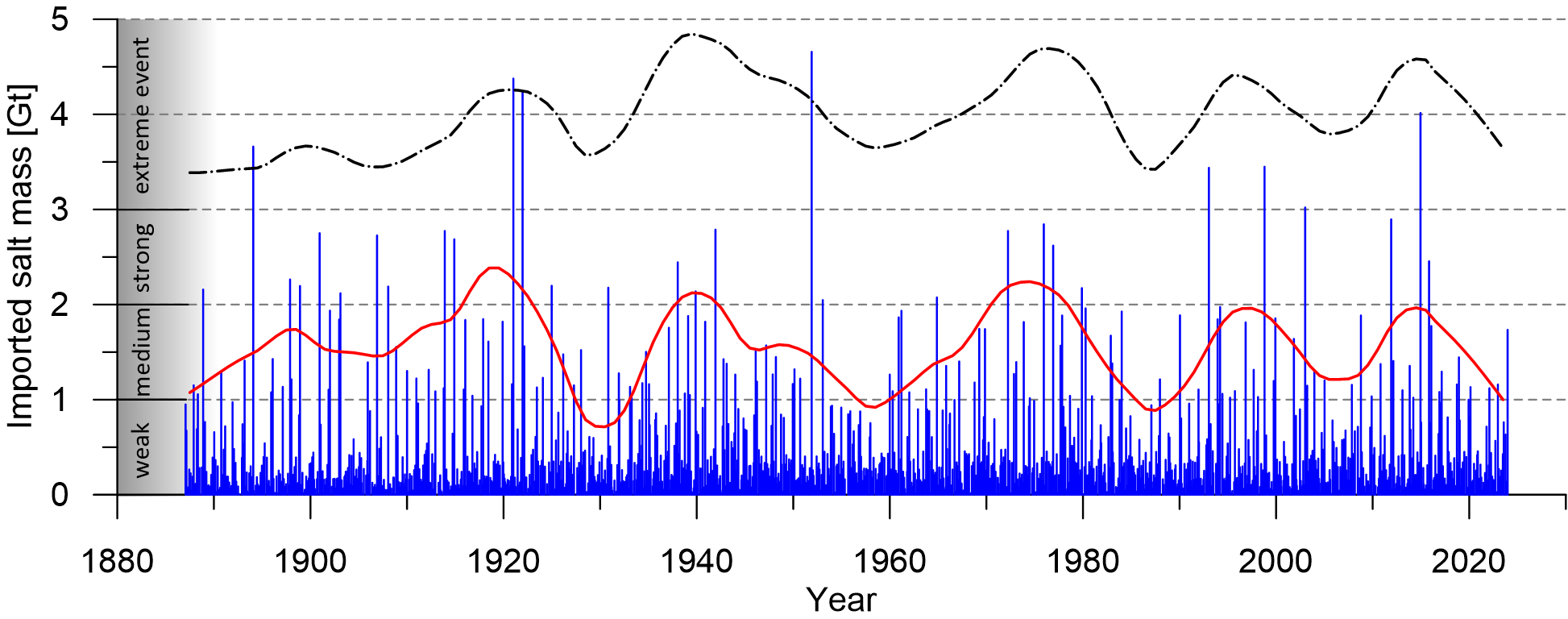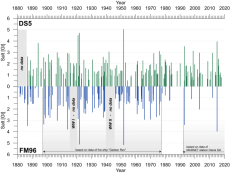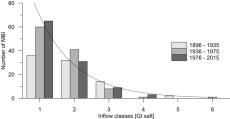
Baltic Saline Barotropic Inflows (SBI) 1887 - 2024
Major Baltic Inflows
Major Baltic inflow events (MBI) transport large amounts of saline water into the Baltic. They are the solely source for deep water ventilation in the central Baltic basins, and control to a large extent the environmental conditions below the halocline. Till 2015 the available time series of MBI frequency and intensity depicted strong decrease of MBI frequency after the 1980ies, followed by long lasting stagnation periods in the central Baltic basins.
The expected long term decrease in mean salinity of the Baltic was not observed. This was explained by a compensation effect of increased frequency of baroclinic saline inflows. Also the frequency of large volume changes of the Baltic has not changed (Lehmann and Post, 2015), and recent model studies predict a slight increase of MBI frequency with warming climate and rising sea level. Additionally, the lack of minor MBI events since the early 1980ies pointed to a bias in the MBI time series.
A revised time series
Triggered by the exceptional MBI observed in December 2014 (Mohrholz et al., 2015) the MBI time series was revised. Using long term data series of sea level, river discharge, and salinity from the Belt and Sound a continuous time series of barotropic inflows was constructed for the period from 1886 till present (DS5). A comparison with the MBI time series FM96 of Fischer and Matthäus (1996) revealed significant differences in the period since the 1980ies (Figure 1). The reasons for the deviations between both time series are mainly the lack of appropriate data between 1976 and 1991, and the change in observation methods afterwards, which caused a systematic bias in the inflow statistics.
The frequency distribution of MBI in the revised time series depicts no statistically significant difference for three subsequent forty year periods (Figure 2). The inflow class distribution follows the expected exponential distribution.
Results
In contrast to earlier investigations the revised MBI time series depicts no significant long term trend in MBI frequency and intensity, contradicting the hypothesis that climate change caused a decreasing MBI frequency.
However, there exists a multi-decadal variability of MBI. Periods with reduced MBI frequency were identified. The revised MBI time series was verified with observations of dissolved oxygen and salinity in the bottom layer of the Bornholm basin.
Until today climate change has no obvious impact on the MBI related oxygen supply to the central Baltic Sea. The increased eutrophication during the last century is most probably the main driver for temporal and spatial spreading of suboxic and anoxic conditions in the deep layer of the Baltic Sea.
Figure 3: Time series of barotropic inflow events from 1886 to 2024 (blue bars). The height of the bars describes the intensity of the individual events in Gt of imported salt. The red curve represents the average annual salt import of all events classified as MBI in Gt of salt per year. The dashed black curve shows the mean annual salt import of all barotropic inflow events in Gt of salt per year.
Data set description
The data set consists of two products. The time series of daily barotropic transports through the Belt and the Sund between 1886 and January 2024, and a list of all barotropic inflow events through the Danish straits.
The data are supplied in ASCII, Matlab and NetCDF format. The transport time series (SBI_1887_2024_trans.*) consists of three parameters:
| Time | -time vector as decimal year [year] |
| Day | -time vector as running day [day] |
| Transport | -volume transport [km3/day] |
The event list (SBI_1887_2024.*) provides for each barotropic inflow event the following parameters:
| Time | -time vector as decimal year [year] |
| Start_Time_Sound | -Start time of saline overflow at Drogden Sill [day] |
| Start_Time_Belt | -Start time of saline overflow at Darss Sill [day] |
| End_Time | -End time of saline overflow at the sills [day] |
| Total_Volume | -total inflow volume [km3] |
| Volume_Sound | -inflow volume at Drogden Sill [km3] |
| Volume_Belt | -inflow volume at Darss Sill [km3] |
| Total_Saline_Volume | -total saline volume [km3] |
| Saline_Volume_Sound | -saline water volume at Drogden Sill [km3] |
| Saline_Volume_Belt | -saline water volume at Darss Sill [km3] |
| Total_Salt | -total amount of salt import [Gt] |
| Salt_Sound | -salt import via Drogden Sill [Gt] |
| Salt_Belt | -salt import via Darss Sill [Gt] |
| Sea_Level_Difference | -sea level difference between start and end of the inflow [m] |
References
Fischer, H., Matthäus, W., 1996. The importance of the Drogden Sill in the Sound for major Baltic inflows. J. Mar. Sys. 9, pp. 137-157
Lehmann, A., Post, P., 2015. Variability of atmospheric circulation patterns associated with large volume changes of the Baltic Sea. Advances in Science and Research 12, pp. 219-225.
Mohrholz, V., Naumann, M., Nausch, G., Krüger, S., Gräwe, U., 2015. Fresh oxygen for the Baltic Sea—An exceptional saline inflow after a decade of stagnation. J. Mar. Sys. 148, pp. 152–166
Mohrholz, V., 2018. Major Baltic Inflow statistics – revised, Front. Mar. Sci., doi.org/10.3389/fmars.2018.00384
This study is part of the Baltic long term observation program of the Leibniz-Institute for Baltic Sea Research Warnemünde.
Data set on barotropic inflows of saline water into the Baltic Sea
DOI: 10.12754/data-2018-0004
Author: Volker Mohrholz, Leibniz-Institute for Baltic Sea Research Warnemünde, Germany (volker.mohrholz@io-warnemuende.de)
A detailed description of the topic and the methods used to compile the data set are given in:
Mohrholz, V., 2018. Major Baltic Inflow statistics – revised, Front. Mar. Sci., doi.org/10.3389/fmars.2018.00384
Please cite this article if the data set is used.


